October was "Women's History Month in Canada," a time to learn about women's and girls' contributions to our country's history, and to reflect on the quality of their lives in the 21st century. A 2012 poll showed Canada to be the best place to be a woman among the G20. But a Save the Children study showed Canada to be ranked 17th among 165 countries in terms of economics, education and health.
Now a 2013 report by the World Economic Forum (WEF) ranks Canada 20th of 133 nations behind Nicaragua (10), Latvia (12), Cuba (15), and Lesotho (16). In 2006, the WEF ranked Canada 14th, falling to 18th in 2007, and 31st in 2008.
The Global Gender Gap Report, which was introduced by the WEF in 2006, provides a framework for capturing the scope and size of gender-based disparities around the world. The index benchmarks national gender gaps on economic, educational, health, and political-based criteria -- allowing for comparison across regions and income groups over time -- to raise awareness of gender disparities and the opportunities created by reducing them.
Overall, the WEF results show that change is slow, even though 86 of 133 countries showed improvements. For five years in a row, Iceland has been rated the country with the world's smallest gender gap. This means it is the country where women are most able to participate fully in their country's economic and political life, and enjoy most equal access to education and healthcare.
The top five spots were rounded out by Finland, Norway, Sweden, and the Philippines, with Europe having seven countries amongst the top 10.
Canada scores well on economics, even though the gap in income between men and women in Canada is 19 per cent. According to the Conference Board, Canada ties with the United States for the 11th spot out of 17 peer countries, and earns a "C" grade. A 2005 Royal Bank of Canada report estimated the lost income potential of women in Canada due to the wage gap at about $126 billion a year.
This critical economic issue is ignored in budget after budget by the government; for example, in the 442-page Economic Action Plan 2013, the phrases "pay equity" and "wage gap" never appear.
According to the WEF, when it comes to health worldwide, the gender gap is most narrow with 96 per cent equality. In fact, many countries tie at the top of the rankings. However, Canada is ranked a shocking 49th.
But Canadians should remember that the tragic gaps in aboriginal health outcomes continue unabated. For a first example, tuberculosis remains a serious health problem in Canada's North; a study in 2010 showed the infection rate among Inuit 185 times greater than for others born in Canada. For a second example, suicide rates are five to seven times higher for First Nations youth than for non-Aboriginal youth. "And suicide rates among Inuit youth are among the highest in the world, at 11 times the national average," according to Health Canada.
When it comes to education, the WEF estimates there is 93 per cent equality, and Canada is ranked jointly at the top with other nations. In fact, in North America, the gender gap has been reversed in tertiary education. The federal government should now be turning its attention to the remaining areas where women are underrepresented, for example, in science, technology, engineering and mathematics.
But according to the WEF, the gender gap is widest in politics. While the highest-ranking Nordic countries have closed more than half of the gap, Canada still ranks a dismal 42nd with men outnumbering women in Parliament by a ratio of three to one. In stark contrast, women held 45 of the 80 seats in Parliament in Rwanda.
It is important for Canada to have more women in politics first and foremost to address the lack of fairness and justice in the institutions that formulate laws and programs that affect women's lives -- especially concerning issues, such as child care, family violence, health care, and pay equity.
Canadians should be demanding that party leaders care about increasing the number of women in Parliament, and that changes be discussed to make politics more attractive to women and that allow for balancing childrearing and service to Canada.
In order to close the gender gap in Canada, Status of Women cannot be a mere token with a budget of just $29 million and only four offices to address the needs of half the Canadian population. But rather, the government must champion women, and not sideline key economic and human rights issues as "women's issues."
It is time we have an equality act, an equality statement with each budget, real engagement with women's groups, and equality impact assessments of policies to see if Canada is actually making progress on such fundamental issues as health and survival and political empowerment.
ALSO ON HUFFPOST:
